The NVIDIA GeForce GTX 1080 & GTX 1070 Founders Editions Review: Kicking Off the FinFET Generation
by Ryan Smith on July 20, 2016 8:45 AM ESTOverclocking
For our final evaluation of the GTX 1080 and GTX 1070 Founders Edition cards, let’s take a look a overclocking.
Whenever I review an NVIDIA reference card, I feel it’s important to point out that while NVIDIA supports overclocking – why else would they include fine-grained controls like GPU Boost 3.0 – they have taken a hard stance against true overvolting. Overvolting is limited to NVIDIA’s built in overvoltage function, which isn’t so much a voltage control as it is the ability to unlock 1-2 more boost bins and their associated voltages. Meanwhile TDP controls are limited to whatever value NVIDIA believes is safe for that model card, which can vary depending on its GPU and its power delivery design.
For GTX 1080FE and its 5+1 power design, we have a 120% TDP limit, which translates to an absolute maximum TDP of 216W. As for GTX 1070FE and its 4+1 design, this is reduced to a 112% TDP limit, or 168W. Both cards can be “overvolted” to 1.093v, which represents 1 boost bin. As such the maximum clockspeed with NVIDIA’s stock programming is 1911MHz.
| GeForce GTX 1080FE Overclocking | ||||
| Stock | Overclocked | |||
| Core Clock | 1607MHz | 1807MHz | ||
| Boost Clock | 1734MHz | 1934MHz | ||
| Max Boost Clock | 1898MHz | 2088MHz | ||
| Memory Clock | 10Gbps | 11Gbps | ||
| Max Voltage | 1.062v | 1.093v | ||
| GeForce GTX 1070FE Overclocking | ||||
| Stock | Overclocked | |||
| Core Clock | 1506MHz | 1681MHz | ||
| Boost Clock | 1683MHz | 1858MHz | ||
| Max Boost Clock | 1898MHz | 2062MHz | ||
| Memory Clock | 8Gbps | 8.8Gbps | ||
| Max Voltage | 1.062v | 1.093v | ||
Both cards ended up overclocking by similar amounts. We were able to take the GTX 1080FE another 200MHz (+12% boost) on the GPU, and another 1Gbps (+10%) on the memory clock. The GTX 1070 could be pushed another 175MHz (+10% boost) on the GPU, while memory could go another 800Mbps (+10%) to 8.8Gbps.
Both of these are respectable overclocks, but compared to Maxwell 2 where our reference cards could do 20-25%, these aren’t nearly as extreme. Given NVIDIA’s comments on the 16nm FinFET voltage/frequency curve being steeper than 28nm, this could be first-hand evidence of that. It also indicates that NVIDIA has pushed GP104 closer to its limit, though that could easily be a consequence of the curve.
Given that this is our first look at Pascal, before diving into overall performance, let’s first take a look at an overclocking breakdown. NVIDIA offers 4 knobs to adjust when overclocking: overvolting (unlocking additional boost bins), increasing the power/temperature limits, the memory clock, and the GPU clock. Though all 4 will be adjusted for a final overclock, it’s often helpful to see whether it’s GPU overclocking or memory overclocking that delivers the greater impact, especially as it can highlight where the performance bottlenecks are on a card.
To examine this, we’ve gone ahead and benchmarked the GTX 1080 4 times: once with overvolting and increased power/temp limits (to serve as a baseline), once with the memory overclocked added, once with GPU overclock added, and finally with both the GPU and memory overclocks added.
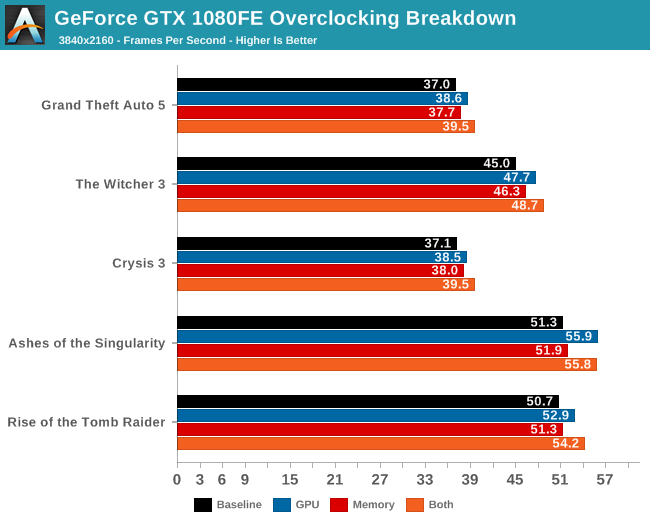
| GeForce GTX 1080 Overclocking Performance | ||||||
| Power/Temp Limit (+20%) | Core (+12%) | Memory (+10%) | Cumulative | |||
| Tomb Raider |
+3%
|
+4%
|
+1%
|
+10%
|
||
| Ashes |
+1%
|
+9%
|
+1%
|
+10%
|
||
| Crysis 3 |
+4%
|
+4%
|
+2%
|
+11%
|
||
| The Witcher 3 |
+2%
|
+6%
|
+3%
|
+10%
|
||
| Grand Theft Auto V |
+1%
|
+4%
|
+2%
|
+8%
|
||
Across all 5 games, the results are clear and consistent: GPU overclocking contributes more to performance than memory overclocking. To be sure, both contribute, but even after compensating for the fact that the GPU overclock was a bit greater than the memory overclock (12% vs 10%), we still end up with the GPU more clearly contributing. Though I am a bit surprised that increasing the power/temperature limit didn't have more of an effect.
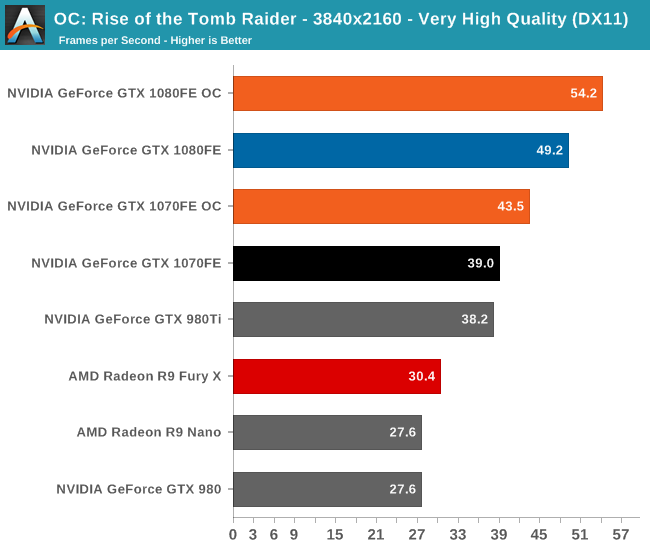
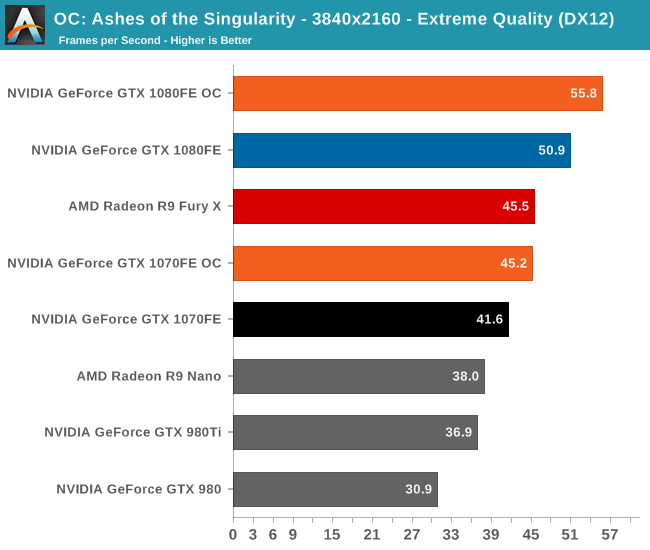

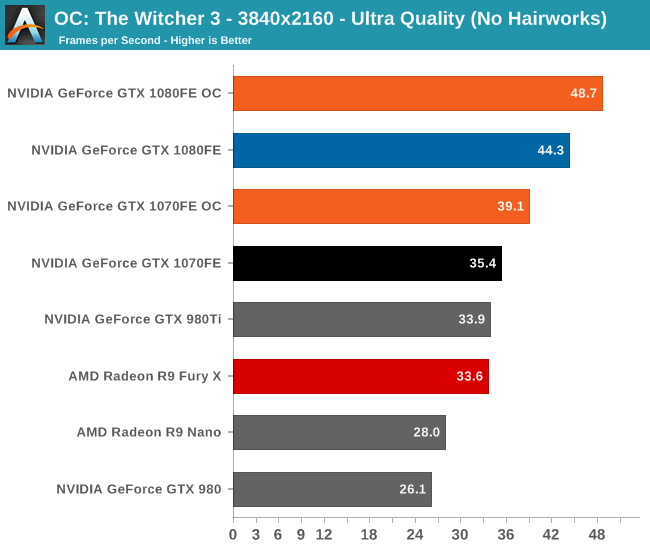
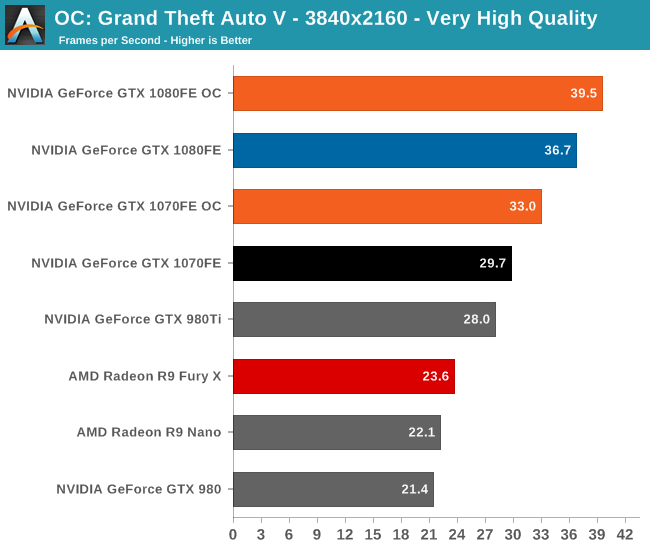
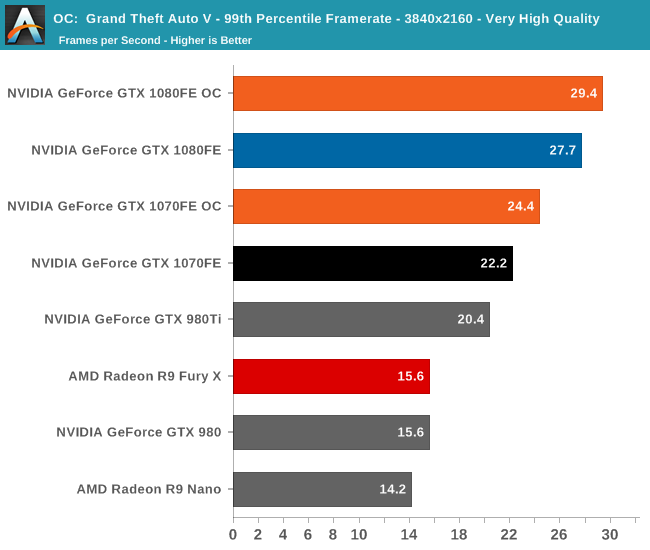
Overall we’re looking at an 8%-10% increase in performance from overclocking. It’s enough to further stretch the GTX 1080FE and GTX 1070FE’s leads, but it won’t radically alter performance.
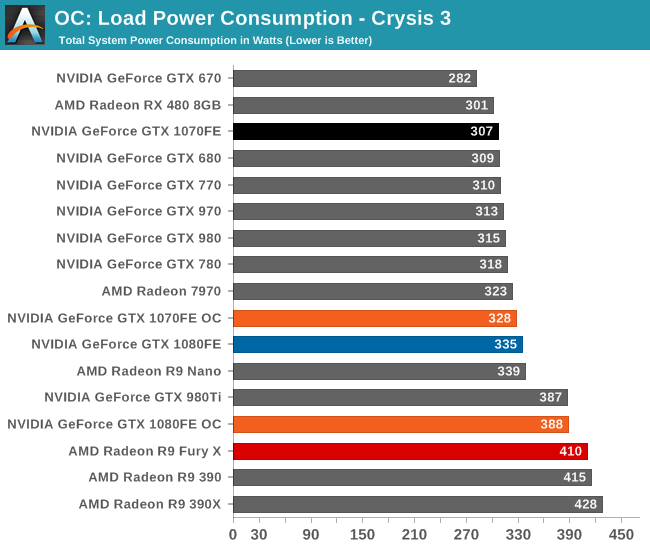
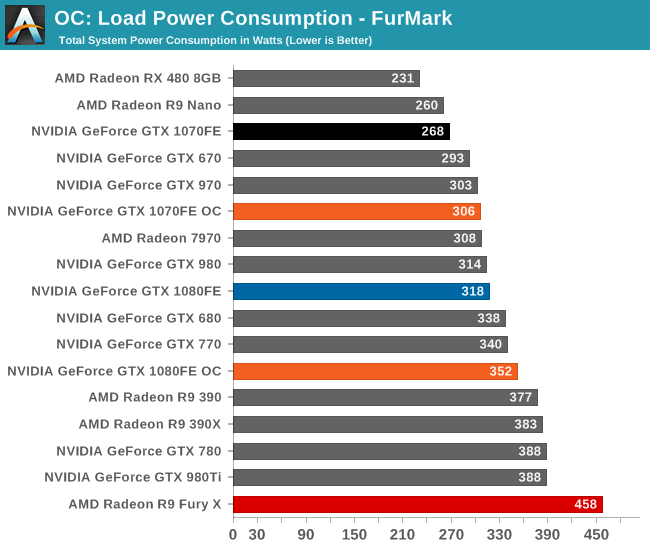
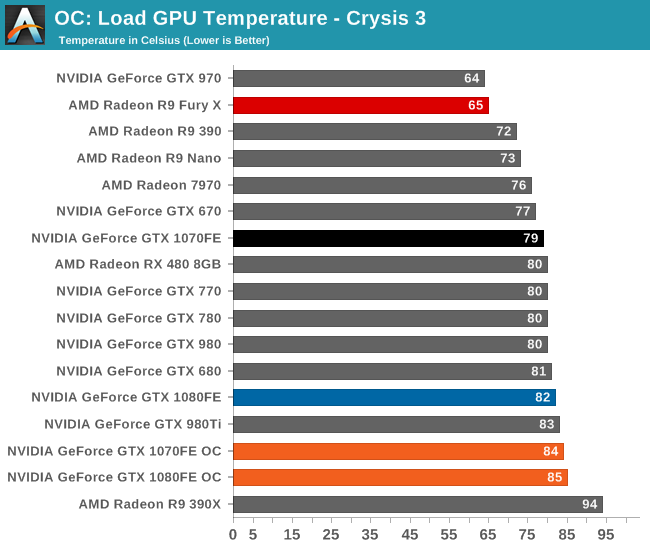

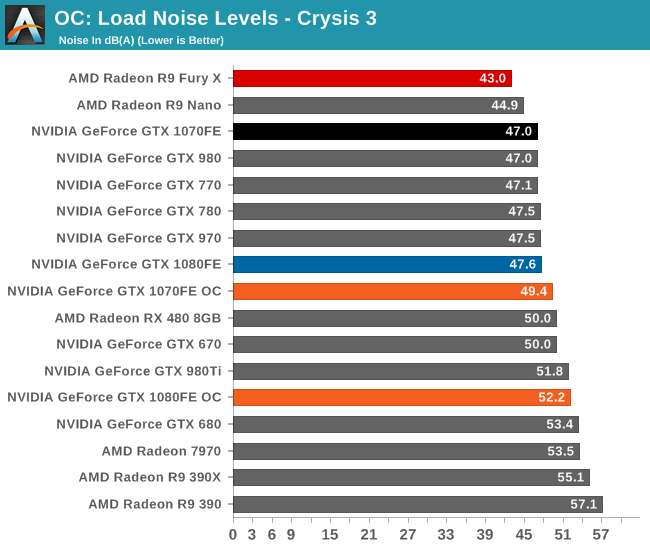
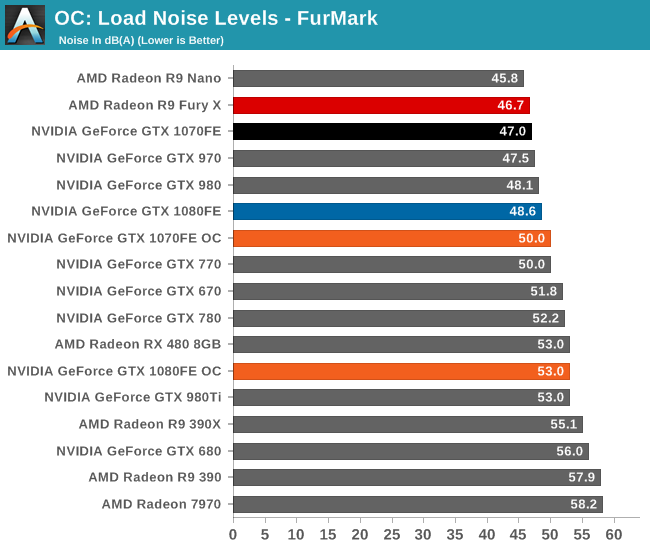
Finally, let’s see the cost of overclocking in terms of power, temperature, and noise. For the GTX 1080FE, the power cost at the wall proves to be rather significant. An 11% Crysis 3 performance increase translates into a 60W increase in power consumption at the wall, essentially moving GTX 1080FE into the neighborhood of NVIDIA’s 250W cards like the GTX 980 Ti. The noise cost is also not insignificant, as GTX 1080FE has to ramp up to 52.2dB(A), a 4.6dB(A) increase in noise. Meanwhile FurMark essentially confirms these findings, with a smaller power increase but a similar increase in noise.
As for the GTX 1070FE, neither the increase in power consumption nor noise is quite as high as GTX 1080FE, though the performance uplift is also a bit smaller. The power penalty is just 21W at the wall for Crysis 3 and 38W for FurMark. This translates to a 2-3dB(A) increase in noise, topping out at 50.0dB for FurMark.










200 Comments
View All Comments
grrrgrrr - Wednesday, July 20, 2016 - link
Solid review! Some nice architecture introductions.euskalzabe - Wednesday, July 20, 2016 - link
The HDR discussion of this review was super interesting, but as always, there's one key piece of information missing: WHEN are we going to see HDR monitors that take advantage of these new GPU abilities?I myself am stuck at 1080p IPS because more resolution doesn't entice me, and there's nothing better than IPS. I'm waiting for HDR to buy my next monitor, but being 5 years old my Dell ST2220T is getting long in the teeth...
ajlueke - Wednesday, July 20, 2016 - link
Thanks for the review Ryan,I think the results are quite interesting, and the games chosen really help show the advantages and limitations of the different architectures. When you compare the GTX 1080 to its price predecessor, the 980 Ti, you are getting an almost universal ~25%-30% increase in performance.
Against rival AMDs R9 Fury X, there is more of a mixed bag. As the resolutions increase the bandwidth provided by the HBM memory on the Fury X really narrows the gap, sometimes trimming the margin to less that 10%,s specifically in games optimized more for DX12 "Hitman, "AotS". But it other games, specifically "Rise of the Tomb Raider" which boasts extremely high res textures, the 4Gb memory size on the Fury X starts to limit its performance in a big way. On average, there is again a ~25%-30% performance increase with much higher game to game variability.
This data lets a little bit of air out of the argument I hear a lot that AMD makes more "future proof" cards. While many Nvidia 900 series users may have to upgrade as more and more games switch to DX12 based programming. AMD Fury users will be in the same boat as those same games come with higher and higher res textures, due to the smaller amount of memory on board.
While Pascal still doesn't show the jump in DX12 versus DX11 that AMD's GPUs enjoy, it does at least show an increase or at least remain at parity.
So what you have is a card that wins in every single game tested, at every resolution over the price predecessors from both companies, all while consuming less power. That is a win pretty much any way you slice it. But there are elements of Nvidia’s strategy and the card I personally find disappointing.
I understand Nvidia wants to keep features specific to the higher margin professional cards, but avoiding HBM2 altogether in the consumer space seems to be a missed opportunity. I am a huge fan of the mini ITX gaming machines. And the Fury Nano, at the $450 price point is a great card. With an NVMe motherboard and NAS storage the need for drive bays in the case is eliminated, the Fury Nano at only 6” leads to some great forward thinking, and tiny designs. I was hoping to see an explosion of cases that cut out the need for supporting 10-11” cards and tons of drive bays if both Nvidia and AMD put out GPUs in the Nano space, but it seems not to be. HBM2 seems destined to remain on professional cards, as Nvidia won’t take the risk of adding it to a consumer Titan or GTX 1080 Ti card and potentially again cannibalize the higher margin professional card market. Now case makers don’t really have the same incentive to build smaller cases if the Fury Nano will still be the only card at that size. It’s just unfortunate that it had to happen because NVidia decided HBM2 was something they could slap on a pro card and sell for thousands extra.
But also what is also disappointing about Pascal stems from the GTX 1080 vs GTX 1070 data Ryan has shown. The GTX 1070 drops off far more than one would expect based off CUDA core numbers as the resolution increases. The GDDR5 memory versus the GDDR5X is probably at fault here, leading me to believe that Pascal can gain even further if the memory bandwidth is increased more, again with HBM2. So not only does the card limit you to the current mini-ITX monstrosities (I’m looking at you bulldog) by avoiding HBM2, it also very likely is costing us performance.
Now for the rank speculation. The data does present some interesting scenarios for the future. With the Fury X able to approach the GTX 1080 at high resolutions, most specifically in DX12 optimized games. It seems extremely likely that the Vega GPU will be able to surpass the GTX 1080, especially if the greatest limitation (4 Gb HBM) is removed with the supposed 8Gb of HBM2 and games move more and more the DX12. I imagine when it launches it will be the 4K card to get, as the Fury X already acquits itself very well there. For me personally, I will have to wait for the Vega Nano to realize my Mini-ITX dreams, unless of course, AMD doesn’t make another Nano edition card and the dream is dead. A possibility I dare not think about.
eddman - Wednesday, July 20, 2016 - link
The gap getting narrower at higher resolutions probably has more to do with chips' designs rather than bandwidth. After all, Fury is the big GCN chip optimized for high resolutions. Even though GP104 does well, it's still the middle Pascal chip.P.S. Please separate the paragraphs. It's a pain, reading your comment.
Eidigean - Wednesday, July 20, 2016 - link
The GTX 1070 is really just a way for Nvidia to sell GP104's that didn't pass all of their tests. Don't expect them to put expensive memory on a card where they're only looking to make their money back. Keeping the card cost down, hoping it sells, is more important to them.If there's a defect anywhere within one of the GPC's, the entire GPC is disabled and the chip is sold at a discount instead of being thrown out. I would not buy a 1070 which is really just a crippled 1080.
I'll be buying a 1080 for my 2560x1600 desktop, and an EVGA 1060 for my Mini-ITX build; which has a limited power supply.
mikael.skytter - Wednesday, July 20, 2016 - link
Thanks Ryan! Much appreciated.chrisp_6@yahoo.com - Wednesday, July 20, 2016 - link
Very good review. One minor comment to the article writers - do a final check on grammer - granted we are technical folks, but it was noticeable especially on the final words page.madwolfa - Wednesday, July 20, 2016 - link
It's "grammar", though. :)Eden-K121D - Thursday, July 21, 2016 - link
Oh the ironychrisp_6@yahoo.com - Thursday, July 21, 2016 - link
oh snap, that is some funny stuff right there